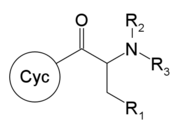Substituted cathinone
This is an old revision of this page, as edited by Enix150 (talk | contribs) at 07:56, 1 February 2011 (→Chemical derivatives). The present address (URL) is a permanent link to this revision, which may differ significantly from the current revision.

Substituted cathinones are derivatives of cathinone, which includes some stimulants and entactogens. They feature a phenethylamine core with an alkyl group attached to the alpha carbon, and a ketone group attached to the beta carbon, along with additional substitutions. Cathinone occurs naturally in the plant khat which is used as a recreational drug [1]
Legality
On 2nd April 2010, the ACMD in the UK announced that a broad structure-based ban of this entire class of compounds would be instituted, following extensive publicity around grey-market sales and recreational use of mephedrone, a common member of the family. This ban covers compounds with the following general structure, with 28 compounds specifically named.[2]
"Any compound (not being bupropion or a substance for the time being specified in paragraph 2.2) structurally derived from 2-amino-1-phenyl-1-propanone by modification in any of the following ways, that is to say,
(i) by substitution in the phenyl ring to any extent with alkyl, alkoxy, alkylenedioxy, haloalkyl or halide substituents, whether or not further substituted in the phenyl ring by one or more other univalent substituents;
(ii) by substitution at the 3-position with an alkyl substituent;
(iii) by substitution at the nitrogen atom with alkyl or dialkyl groups, or by inclusion of the nitrogen atom in a cyclic structure."
— ACMD, 2nd April 2010
This text was added as an amendment to the Misuse of Drugs Act 1971, to come into force on 16 April 2010.[3]

- R1 = hydrogen, or any combination of one or more alkyl, alkoxy, alkylenedioxy, haloalkyl or halide substituents
- R2 = hydrogen or any alkyl group
- R3 = hydrogen, any alkyl group, or incorporation in a cyclic structure
- R4 = hydrogen, any alkyl group, or incorporation in a cyclic structure
Chemical derivatives
| Compound | R1 | R2 | R3 | R4 |
| Cathinone | no substitution | hydrogen | hydrogen | hydrogen |
| Methcathinone | no substitution | hydrogen | hydrogen | methyl |
| Ethcathinone | no substitution | hydrogen | hydrogen | ethyl |
| Buphedrone | no substitution | methyl | hydrogen | methyl |
| Pentedrone | no substitution | ethyl | hydrogen | methyl |
| Dimethylcathinone | no substitution | hydrogen | methyl | methyl |
| Diethylpropion | no substitution | hydrogen | ethyl | ethyl |
| Bupropion | 3-chloro | hydrogen | hydrogen | t-butyl |
| Mephedrone | 4-methyl | hydrogen | hydrogen | methyl |
| 3-MMC | 3-methyl | hydrogen | hydrogen | methyl |
| 4-EMC | 4-ethyl | hydrogen | hydrogen | methyl |
| 4-MEC | 4-methyl | hydrogen | hydrogen | ethyl |
| N,N-DMMC | 4-methyl | hydrogen | methyl | methyl |
| N,N-DEMC | 4-methyl | hydrogen | ethyl | ethyl |
| 3,4-DMMC | 3,4-dimethyl | hydrogen | hydrogen | methyl |
| Methedrone | 4-methoxy | hydrogen | hydrogen | methyl |
| 2-FMC | 2-fluoro | hydrogen | hydrogen | methyl |
| 3-FMC | 3-fluoro | hydrogen | hydrogen | methyl |
| Flephedrone | 4-fluoro | hydrogen | hydrogen | methyl |
| Brephedrone | 4-bromo | hydrogen | hydrogen | methyl |
| bk-MDA | 3,4-methylenedioxy | hydrogen | hydrogen | hydrogen |
| Methylone | 3,4-methylenedioxy | hydrogen | hydrogen | methyl |
| Ethylone | 3,4-methylenedioxy | hydrogen | hydrogen | ethyl |
| bk-IMP | 3,4-trimethylene | hydrogen | hydrogen | methyl |
| 4-Fluorobuphedrone | 4-fluoro | methyl | hydrogen | methyl |
| 4-Methylbuphedrone | 4-methyl | methyl | hydrogen | methyl |
| Butylone | 3,4-methylenedioxy | methyl | hydrogen | methyl |
| Eutylone | 3,4-methylenedioxy | methyl | hydrogen | ethyl |
| bk-DMBDB | 3,4-methylenedioxy | methyl | methyl | methyl |
| 5-Methylmethylone | 3,4-methylenedioxy-5-methyl | hydrogen | hydrogen | methyl |
| 2-Methylbutylone | 2-methyl-3,4-methylenedioxy | methyl | hydrogen | methyl |
| 5-Methylbutylone | 3,4-methylenedioxy-5-methyl | methyl | hydrogen | methyl |
| Pentylone | 3,4-methylenedioxy | ethyl | hydrogen | methyl |
| α-Phthalimidopropiophenone | no substitution | hydrogen | phthalimido | |
| α-PPP | no substitution | hydrogen | pyrrolidinyl | |
| α-PBP | no substitution | methyl | pyrrolidinyl | |
| 4-Et-α-PBP | 4-ethyl | methyl | pyrrolidinyl | |
| 4-MeO-α-PBP | 4-methoxy | methyl | pyrrolidinyl | |
| α-PVP | no substitution | ethyl | pyrrolidinyl | |
| MPPP | 4-methyl | hydrogen | pyrrolidinyl | |
| MOPPP | 4-methoxy | hydrogen | pyrrolidinyl | |
| MPBP | 4-methyl | methyl | pyrrolidinyl | |
| Pyrovalerone | 4-methyl | ethyl | pyrrolidinyl | |
| MPHP | 4-methyl | n-propyl | pyrrolidinyl | |
| MDPPP | 3,4-methylenedioxy | hydrogen | pyrrolidinyl | |
| MDPBP | 3,4-methylenedioxy | methyl | pyrrolidinyl | |
| MDPV | 3,4-methylenedioxy | ethyl | pyrrolidinyl | |
| Naphyrone | β-naphthyl instead of phenyl | ethyl | pyrrolidinyl | |
| bk-Methamthetamine | thiophen-2-yl instead of phenyl | hydrogen | hydrogen | methyl |
| α-PVT | thiophen-2-yl instead of phenyl | ethyl | pyrrolidinyl | |
Note that four of the above compounds (cathinone, methcathinone, diethylpropion and pyrovalerone) were already illegal in the UK at the time the ACMD report was issued. Two compounds were specifically excluded from the ban, these being bupropion because of its common use in medicine and relative lack of abuse potential, and naphyrone because its structure falls outside the generic definition and not enough evidence was yet available to justify a ban. Naphyrone was however subsequently banned in July 2010 following a further review by the ACMD,[4][5] along with a further broad based structure ban even more expansive than the last.[6]
- Naphyrone analogues
“Any compound structurally derived from 2–aminopropan–1–one by substitution at
the 1-position with any monocyclic, or fused-polycyclic ring system (not being a phenyl ring or alkylenedioxyphenyl ring system), whether or not the compound is further modified in any of the following ways, that is to say—
(i) by substitution in the ring system to any extent with alkyl, alkoxy, haloalkyl or halide substituents, whether or not further substituted in the ring system by one or more other univalent substituents;
(ii) by substitution at the 3–position with an alkyl substituent;
(iii) by substitution at the 2-amino nitrogen atom with alkyl or dialkyl groups, or
by inclusion of the 2-amino nitrogen atom in a cyclic structure.”
— Home Office, 13th July 2010.

- Cyc = any monocyclic, or fused-polycyclic ring system (not being a phenyl ring or alkylenedioxyphenyl ring system), including analogues where the ring system is substituted to any extent with alkyl, alkoxy, haloalkyl or halide substituents, whether or not further substituted in the ring system by one or more other univalent substituents
- R1 = hydrogen or any alkyl group
- R2 = hydrogen, any alkyl group, or incorporation in a cyclic structure
- R3 = hydrogen, any alkyl group, or incorporation in a cyclic structure
See also
- Markush structure
- Substituted phenethylamines
- Substituted amphetamines
- Substituted methylenedioxyphenethylamines
References
- ^ AJ Giannini,H Burge, WA Price, JA Shaheen,. Khat:Another drug of abuse. Journal of Psychoactive Drugs. 18:155-121,1986. PMID 3734955
- ^ ACMD report on the consideration of the cathinones. Advisory Council on the Misuse of Drugs (UK), 2nd April 2010
- ^ "The Misuse of Drugs (Amendment) (England, Wales and Scotland) Regulations 2010 No. 1144". Opsi.gov.uk. Retrieved 2010-04-08.
- ^ "NRG-1 'legal high' drug is banned". BBC News. 2010-07-12. Retrieved 2010-07-17.
- ^ "Advisory Council on the Misuse of Drugs Naphyrone Report (2010)". Home Office. 2010-07-07. Retrieved 2010-07-17.
- ^ "Explanatory Memorandum To The Misuse of Drugs (Amendment No. 2) (England, Wales and Scotland) Regulations 2010 No. 1799" (PDF). Opsi.gov.uk. Retrieved 2010-07-18.
- ^ "The Misuse of Drugs (Amendment No. 2) (England, Wales and Scotland) Regulations 2010 No. 1799" (PDF). Opsi.gov.uk. Retrieved 2010-07-18.
| Phenylalkyl- amines (other than cathinones) |
|
|---|---|
| Cyclized phenyl- alkylamines | |
| Cathinones | |
| Tryptamines | |
| Chemical classes | |
| α1 |
| ||||
|---|---|---|---|---|---|
| α2 |
| ||||
| β |
| ||||
| D1-like |
| ||||||
|---|---|---|---|---|---|---|---|
| D2-like |
| ||||||
| 5-HT1 |
| ||||||||||||||||||||||||||||||||||||||
|---|---|---|---|---|---|---|---|---|---|---|---|---|---|---|---|---|---|---|---|---|---|---|---|---|---|---|---|---|---|---|---|---|---|---|---|---|---|---|---|
| 5-HT2 |
| ||||||||||||||||||||||||||||||||||||||
| 5-HT3–7 |
| ||||||||||||||||||||||||||||||||||||||
| Phenethylamines |
|
|---|---|
| Amphetamines |
|
| Phentermines |
|
| Cathinones |
|
| Phenylisobutylamines | |
| Phenylalkylpyrrolidines | |
| Catecholamines (and close relatives) |
|
| Miscellaneous |
|
This hallucinogen-related article is a stub. You can help Wikipedia by expanding it. |
